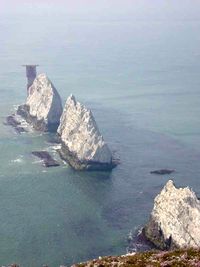Chalk
| Chalk | |
|---|---|
| — Sedimentary Rock — | |
 |
|
| The Needles, situated on the Isle of Wight, are part of the extensive Southern England Chalk Formation. | |
| Composition | |
| calcite (calcium carbonate) |
Chalk (pronounced /ˈtʃɔːk/) is a soft, white, porous sedimentary rock, a form of limestone composed of the mineral calcite. Calcite is calcium carbonate or CaCO3. It forms under relatively deep marine conditions from the gradual accumulation of minute calcite plates (coccoliths) shed from micro-organisms called coccolithophores. It is common to find chert or flint nodules embedded in chalk. Chalk can also refer to other compounds including magnesium silicate and calcium sulfate.
Chalk is resistant to weathering and slumping compared to the clays with which it is usually associated, thus forming tall steep cliffs where chalk ridges meet the sea. Chalk hills, known as chalk downland, usually form where bands of chalk reach the surface at an angle, so forming a scarp slope. Because chalk is porous it can hold a large volume of ground water, providing a natural reservoir that releases water slowly through dry seasons.
Contents |
Deposits
The Chalk Group is a European stratigraphic unit deposited during the late Cretaceous Period. It forms the famous White Cliffs of Dover in Kent, England, as well as their counterparts of the Cap Blanc Nez on the other side of the Dover Strait. The Champagne region of France is mostly underlain by chalk deposits, which contain artificial caves used for wine storage. Some of the highest chalk cliffs in the world occur at Møns Klint in Denmark.
Formation
Ninety million years ago the chalk downland of Northern Europe was ooze at the bottom of a great sea. Protozoans such as foraminifera lived on the marine debris that showered down from the upper layers of the ocean. Their bodies were made of chalk extracted from the rich sea-water. As they died a deep layer built up and slowly became consolidated into rock. At a later date the sea-bed became dry land, as earth movements thrust it upward.
Composition
Chalk is composed mostly of calcium carbonate with minor amounts of silt and clay. It is normally formed underwater, commonly on the sea bed, then consolidated and compressed during diagenesis into the form commonly seen today. During diagenesis silica accumulates to form chert or flint nodules within the carbonate rock.
Uses
Chalk is used to make quicklime and slaked lime, mainly used as lime mortar in buildings. In southeast England, Deneholes are a notable example of ancient chalk pits. Such bell pits may also mark the sites of ancient flint mines, where the prime object was to remove flint nodules for stone tool manufacture. The surface remains at Cissbury are one such example, but perhaps the most famous is the extensive complex at Grimes Graves in Norfolk.
The traditional uses of chalk have in some cases been replaced by other substances, although the word "chalk" is often still applied to the replacements.
- Blackboard chalk is a substance used for drawing on rough surfaces, as it readily crumbles leaving particles that stick loosely to these surfaces. Although traditionally composed of natural chalk, modern blackboard chalk is generally made from the mineral gypsum (calcium sulfate), often supplied in sticks of compressed powder about 10 cm long.
- Sidewalk chalk is similar to blackboard chalk, except that it is formed into larger sticks and often colored. It is used to draw on sidewalks, streets, and driveways, mostly by children, but also by adult artists.
- In agriculture chalk is used for raising pH in soils with high acidity. The most common forms are CaCO3 (calcium carbonate) and CaO (calcium oxide).
- In field sports, including grass tennis courts, powdered chalk was used to mark the boundary lines of the playing field or court. This gives the advantage that, if the ball hits the line, a cloud of chalk or pigment dust can be seen. Nowadays the substance used is mostly titanium dioxide.[1]
- In gymnastics, rock-climbing, weight-lifting and tug of war, chalk—now usually magnesium carbonate—is applied to the hands to remove perspiration and reduce slipping.
- Tailor's chalk is traditionally a hard chalk used to make temporary markings on cloth, mainly by tailors. Nowadays it is usually made from talc (magnesium silicate).
- Toothpaste also commonly contains small amounts of chalk, to serve as a mild abrasive.
- Polishing chalk is chalk prepared with a carefully controlled grain size, for very fine polishing of metals.[2]
- Chalk is a source of quicklime by thermal decomposition, or slaked lime following quenching with water.
- Builders putty also mainly contains chalk as a filler in linseed oil.
- Woodworking joints may be fitted by chalking one of the mating surfaces. A trial fit will leave a chalk mark on the high spots of the corresponding surface. Chalk transferring to cover the complete surface indicates a good fit.
See also
- Chalk carving
- Chalk line
- Flint
- French chalk
- Hill figure
- Pastel
- Sanguine
References
- ↑ "Light spells doom for bacteria". http://www.photonics.com/Content/ReadArticle.aspx?ArticleID=35722.
- ↑ Information on polishing powders, from the 1879 book "The Workshop Companion"